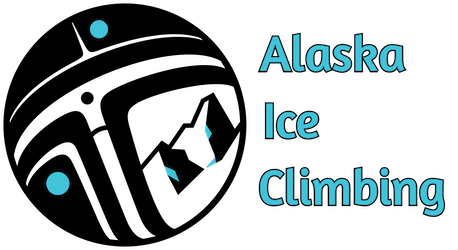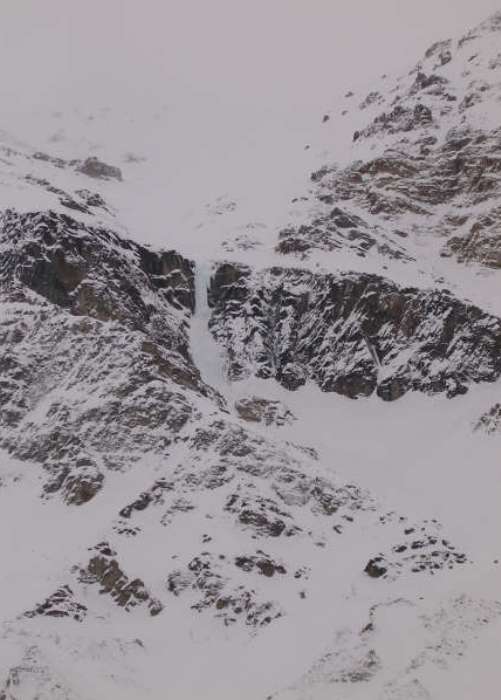Head north past the entrance to the Denali National Park and drive through the community of Healy. Eventually, one will cross the high bridge over the Nenana River and find the climbs at the Johnny Cash Falls.
Category: ice guide
Fox Creek
Rating: WI3
Length: 50 meters
This is a relatively moderate and short route but is rather wide and can accommodate several climbing groups. It is possible to gain access on the left gully to the top of the route to set up a top-rope. There is also an interesting rock wall to the left of the main ice route for challenging mixed terrain. A tree is easily accessible on the top of the rock route.
FA:
Anchor/Descent: Trees are present for a rappel. A walk off is possible.
Dragonfly Creek
Rating: WI3
Length: 2 distinct pillars, 10 meters and 20 meters, 40-50 meters total
This route is composed of two steps that can be combined into a short pitch. The first step holds a couple of different variations on interesting ice and some rock on the right in thin conditions. The second step climbs more moderate ice back to the rap anchor. The location of this climb with Nenana Valley below makes this climb worth the trip.
FA:
Descent: Alder bushes at the top exist for the rap.
Rode Hard, Put Away Wet
Rating: WI3/4
Length: 130 meters
This middle route of the three consists of good WI 3 with some WI 5 moves. Steep but short pillars, rotten mixed moves, and enjoyable cruising.
FA: Luke Lohmuller & Bob Shelton, October 2010
Anchor/Descent: Walk off to the left to a steep gulley that takes you back to the base of the routes or rap via v-thread.
Polychrome Mountain
Getting to Polychrome Mountain in the winter or fall is obviously one of the biggest challenges for accessing the routes. The road is closed this time of year so you will have to work out the logistics for traveling approximately 50 miles. And, you will need to time it right when the conditions are in. You may just get lucky enough to get everything right to get an ascent on the ice on Polychrome.
Denali National Park
Denali National Park is home to the Great One, the tallest mountain in North America. Many mountaineers visit the park by plane departing from Talkeetna to challenge themselves in the peaks of the Alaska Range. Other climbers access DNP by the single road leading into the park or by backcountry skis or dog sled team. It’s the limited access that helps DNP retain its original wilderness and can help to ensure a remote climbing experience for the true adventurer.
North Parks Highway
From Anchorage, drive north on the Glenn Highway approximately 45 minutes. Take the Parks Highway west and north on the Parks for another 3 to 3.5 hours through Wasilla, Talkeetna, and Cantwell. This area exists north of the turnoff for the Denali Highway and most of the climbs in this area are located just outside of the entrance to Denali National Park.
Triangle Peak 2
Rating:
Length: 650 meters
A long 1500′ (approx.) snow couloir (50-60 degress max) climb is necessary to approach the base of this route. Ths couloir trends up to a large headwall with a pencil like pillar coming down the middle. The first step of ice is a long 40-50 meter slab of 60-70 degree ice to the base of what looks to be a 40 meter freestanding pillar.
FA:
Anchor/Descent: Be prepared to set a V-thread for the descent.
![]() ALERT: Avalanche basin is located directly above the pillar and it looks dangerous in all but the best snow conditions.
ALERT: Avalanche basin is located directly above the pillar and it looks dangerous in all but the best snow conditions.
Triangle Peak 1
Rating:
Length: 400 meters
This route consists of 3 ice steps, each around 30-40 meters long. The first step appears to be around 70 degrees. The second and third steps appears steeper at 80 degrees. The total length of the route is probably around 1000′ maybe 1250’ish, from the base of the first ice step. Probably, another 500 feet of climbing the bottom snow gully will put one on the first ice step. Steep snow couloir steps between the ice.
FA:
Anchor/Descent: Be prepared to set a V-thread for the descent.
Triangle Peak
The climbs on Triangle Peak are accessed via the Castner Glacier east of the Richardson Highway. Hike the center/middle of the glacier to avoid the rough terrain on the south side of the glacier. Hike to approximately 63.40388 North -145.63366 West on the glacier and turn south to the base of the climbs, 700 feet elevation gain and 3/4 mile distance.




